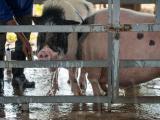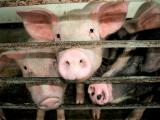Jun 11, 2009 (CIDRAP News) – At almost the same moment today that the World Health Organization announced recognition of an influenza pandemic, researchers from Hong Kong, the United Kingdom and the United States declared that the novel H1N1 virus responsible has been circulating undetected in humans for months—and that its components have been present in pigs for at least a decade.
The group, led by Andrew Rambaut, PhD, of the University of Edinburgh's Institute of Evolutionary Biology, said in a letter to the journal Nature that their findings demonstrate the critical need to ramp up disease-detection efforts in animals: "Despite widespread influenza surveillance in humans, the lack of systematic swine surveillance allowed for the undetected persistence and evolution of this potentially pandemic strain for many years."
If better surveillance had existed, they suggest, the first flu pandemic in 41 years might have been detected much earlier—because the novel H1N1 strain's evolution tracks with the emergence of earlier and (as yet) more destructive pandemic strains.
"All three pandemics of the 20th century seem to have been generated by a series of multiple reassortment events in swine or humans, and to have emerged over a period of years before pandemic recognition," they write. "Our results show that the genesis of the [swine-origin influenza A H1N1 virus] epidemic followed a similar evolutionary pathway."
The study is the third in 3 weeks to pinpoint the origin of the novel H1N1 strain of flu in pigs in North America, where it underwent complex reassortment. On May 22, a group of 60 scientists led by researchers at the Centers for Disease Control and Prevention published in the journal Science an analysis of full or partial genomes from 76 viral isolates. And on June 4, scientists from the National Autonomous University of Mexico and the University of Illinois published in Eurosurveillance an analysis of 400 protein sequences.
Taken together, the three papers demonstrate an uncharacteristic scientific openness that has been allowing analysis of the novel flu to move at a record pace. In the case of today's paper, its authors have been posting their findings piece by piece on the Internet, in a multi-author wiki (http://tree.bio.ed.ac.uk/groups/influenza/), and their paper was released by Nature without embargo, in what the journal termed a "near-final version."
To reach their results, Rambaut and colleagues compared the downloaded genetic sequences of 2 isolates of the novel flu, 15 newly sequenced Asian swine flu strains, and 796 human, swine, and avian flu isolates. In addition, using a "molecular clock" technique, they calculated the rate of viral evolution of 30 isolates of the novel flu.
Their study yielded a reconstruction of the sequence of reassortment events that produced the new strain. It graphically depicts how braided and complex the evolution of the novel flu has been. Along with it, they publish phylogenetic analyses ("family trees") for the major genomic segments of the new virus that, by depicting the time gaps between known isolates, illustrate how little surveillance of swine influenza has been carried out.
They conclude that the eight genomic segments of the novel H1N1 have been circulating in swine populations for a number of years, from 9.24 years at the shortest (for the PB1 gene) to 17.15 years at the outside (for the NA gene).
The complete virus, they estimate, has been circulating in humans since approximately January 2009, and may have emerged as early as August 2008.
"This genomic structure may have been circulating in pigs for several years before emergence in humans," they said. "We urge caution in making inferences about human adaptation on the basis of the ancestry of the individual genes."
Movement of live pigs between Eurasia and North America is likely to have facilitated viral reassortment, they said. Notably, they found a striking resemblance to the novel H1N1 in a 2004 swine influenza isolate from Hong Kong that contained 7 out of 8 genes similar enough for them to dub it a "sister lineage." They caution though that this does not prove a Eurasian origin for the new flu, but only provides evidence that its swine-flu progenitors were widely geographically distributed.
Smith GJD, Vijaykrishna D, Bahl J, et al. Origins and evolutionary genomics of the 2009 swine-origin H1N1 influenza A epidemic. Nature 2009 (advance online publication Jun 11) [Abstract]
See also:
May 22 CIDRAP News story "Genetic study: Novel H1N1 likely originated in pigs"
Garten RJ, Davis CT, Russell CA, et al. Antigenic and genetic characteristics of swine-origin 2009 A (H1N1) influenza viruses circulating in humans. Science 2009 (early online publication May 22) [Abstract]
Jun 8 CIDRAP News story "Flu researchers call for enhanced swine surveillance"
Nava GM, Attene-Ramos MS, Ang JK, et al. Origins of the new influenza A (H1N1) virus: time to take action. Eurosurveillance 2009 Jun 4;14(22) [Full text]




















